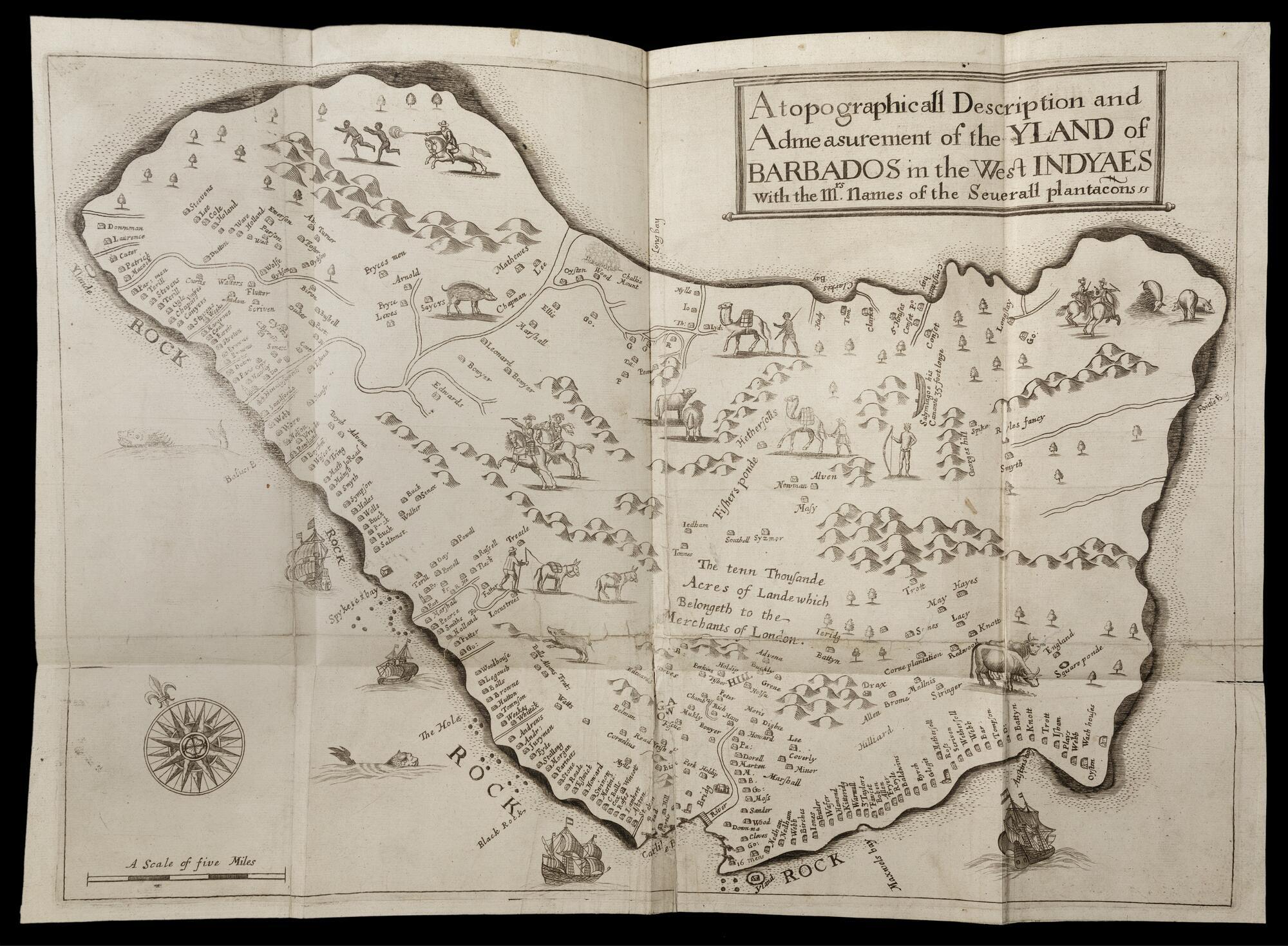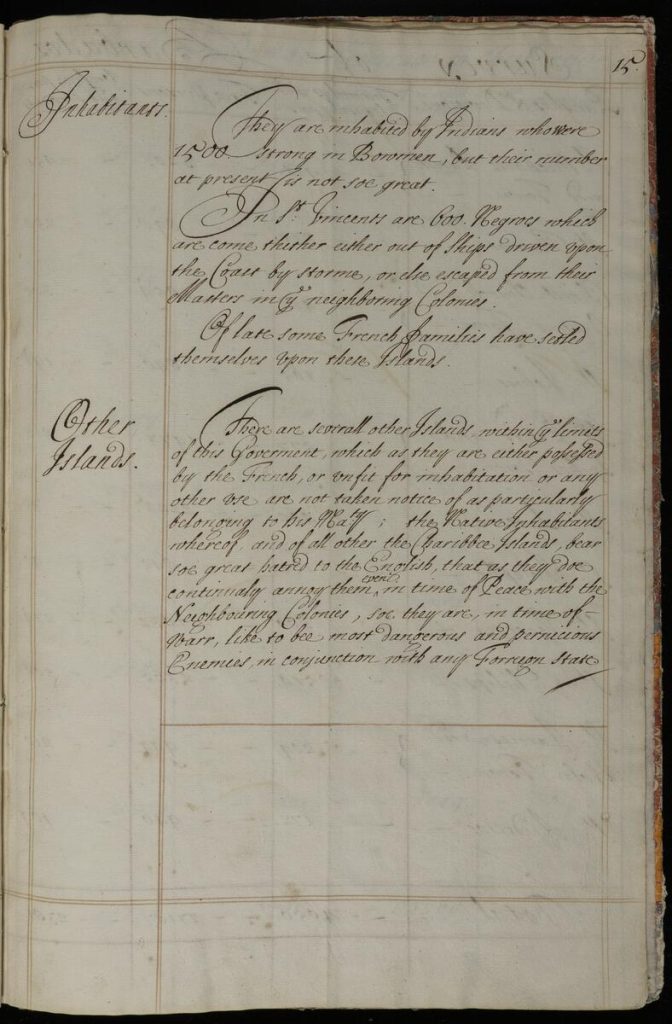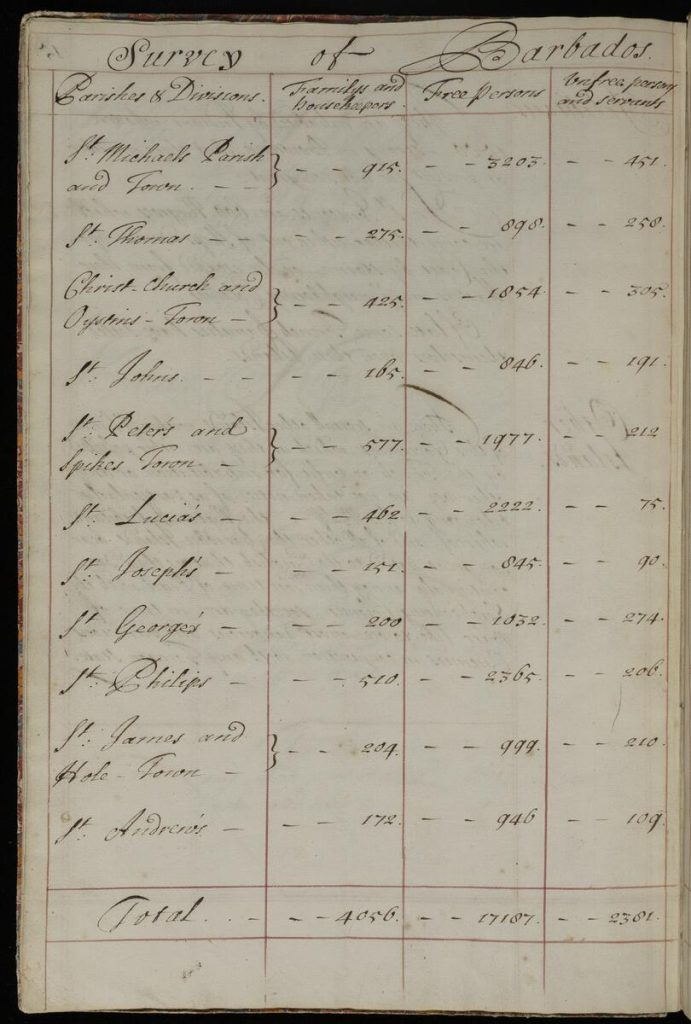Curriculum Connections: African American History, British Empire, The Caribbean, Colonization, Early Modern Race, Enslavement, Indigenous History, Resistance
Materials – Available for Download in the Downloads Tab:
- Image of excerpt from The State of Barbados (high-resolution version)
- Transcript of excerpt from The State of Barbados
- Optional: Map from A True & Exact History of Barbados (high-resolution version)
- Source analysis worksheet
Purpose & Learning Objectives
This lesson will help students see evidence of marginalized peoples actively resisting the injustice of colonization and enslavement in the 1600s.
This lesson is built around a handwritten bureaucratic document that was made to record important information about the English colony on Barbados. As students will see, that information includes a brief account of Black Africans and Indigenous people standing up against English colonial power, the sort of information that was deliberately left out of most other historical sources from the period.
At the end of the lesson, students will understand some key points about history and traditionally marginalized communities. These points include:
- There is clear historical evidence that marginalized communities actively resisted colonizers and enslavers in the seventeenth century.
- These stories are often highly distorted or erased altogether in sources created by white European authors, especially when those sources were intended for white European audiences.
- Despite these attempts at erasure, it is possible to recover the histories and experiences of marginalized groups through archival research, especially when that research uses sources that public audiences were never supposed to see.
Process
This lesson is for a teacher-controlled class. However, students can also perform this lesson independently or in small groups. For this option, download the copies of the source images in the Downloads tab or give them the link to the Newberry collections (above under Materials).
The lesson structure for this lesson is intended for a full class session. It involves three steps: image study, excerpt study, and reflection. By following these steps, students will learn how to see stories of resistance in historical documents.
Historical context on this period and more information on the source in the Background section below.
Step 1: Image Study
Begin by displaying or distributing images of The State of Barbados. For this stage, any images are fine, but the most important page to focus on is page 15 of the document.
Students can use the student source analysis worksheet in the Downloads tab for this step.
Give the students some time to look at the image(s) and describe what they see. Guiding questions to help this discussion include:
- What do you see in this image?
- Does this source have images in it? If not, why not?
- Is this source easy for you to read? Why or why not?
- Does this source look like other books you’ve seen before?
- Why do you think this source was made?
- What questions do you have about this source?
Takeaways
In many ways, the difficulty of reading this source is the whole point of this first step. This source was not made to be easily understood or interpreted by anyone other than colonial officials. It is, in a certain sense, a “private” document. At the same time, this “privacy” also means that the information in this source is more likely to be accurate than the information someone would find in, for example, a printed history of Barbados that was meant to be read by the public (see the Optional Extension Activity below).
Step 2: Excerpt Study
After the image study, either display, distribute, or read aloud the provided excerpt, which is transcribed from page 15 of the document.
Students can also use the source analysis worksheet in the Downloads tab for this step.
Note on Reading the Excerpt
Reading seventeenth-century English colonial sources is difficult even for experts. The following are some challenges that students may encounter when performing this step….
- Content – As with any colonial source, The State of Barbados speaks directly about the violent and dehumanizing aspects of enslavement. Teachers should be sure their students are prepared to encounter this content before reading the excerpt.
- Language – This source uses the term “Negroes” to refer to enslaved Black people from West Africa, and “Native” to refer to Indigenous communities in Barbados. These were commonly used terms at the time, but teachers are encouraged to use more respectful terms (e.g., “enslaved West Africans” or “Indigenous communities”) when discussing the excerpt.
- Spelling – The English language did not have firm rules for spelling in the 1600s, so students may find this excerpt very difficult to read. Remind the students that reading the words out loud is a helpful way to figure out difficult words, and that they do not need to understand every single word to make sense of the excerpt.
For more on reading a transcription, use this Skills Lesson.
In St. Vincents [an island near Barbados] are 600 Negroes [that is, enslaved West Africans] which are come thither either out of Ships driven upon the Coast by storme, or else escaped from their Masters in (the) neighboring Colonies.
There are several other Islands within (the) limits of this [colonial] Government, which as they are either possessed by the French, or unfit for inhabitation or any other use are not taken notice of as particularly belonging to his Majesty [the king of England]; the Native Inhabitants whereof, and of all other the Caribbe Islands, bear so great hatred to the English, that as they doe continualy annoy them, even in time of Peace with the Neighbouring Colonies, soe they are in time of Warr, like to be most dangerous and pernicious Enemies, in conjunction with any Forreign State.
The State of Barbados, 15
After reading the source, have the students discuss what it tells them about the actions, motivations, and mindsets of Black Africans and Indigenous peoples in 1684. Some guiding questions to help with this discussion include:
- What are Black Africans and Indigenous people doing in this excerpt?
- What do you think “annoy” means in this context? (Though it sounds fairly tame, in the seventeenth century the word meant “to attack.”)
- How does the English author of this excerpt seem to feel about what Black Africans and Indigenous people are doing? (Pay special attention to the final sentence of the excerpt).
- Does reading the excerpt answer any of the questions you had about the source? Do you have any new questions?
Takeaways
Despite its odd language, this excerpt should make clear to the students that the Black Africans and Indigenous people not only recognized the injustice and brutality of colonialism and enslavement in the 1600s, but were also willing to violently resist it. The author of this document, at least, also recognized how the “hatred” of these communities toward the English represented a real threat to the very existence of an English colony on Barbados, should a war break out between England and other colonial powers like France.
Step 3: Reflection
In the final step of this lesson, students will be invited to think about what this information tells them about the history of marginalized communities under English colonialism in the 1600s. Some guiding questions to help this reflection include:
- Were you surprised by any of the information you found in this source?
- After reading this source, what do you now know about the experience of marginalized communities in Barbados in the 1600s?
- How did the information you found about marginalized communities in this source make you feel?
- Does this source make you think or feel differently about the world you see now?
- What new questions do you have about this source or this history?
Takeaways
After this activity, the students will hopefully understand that there is evidence of marginalized and oppressed groups actively resisting the injustice and violence of colonialization and enslavement. This sort of information is not often found in other sources from this period (see the optional extension activity below), which leads to the idea that those histories can be erased, since history “is written by the victors.” However, sources like The State of Barbados, while still quite problematic, can show that these attempts at erasure are never completely successful, and that the histories and experiences of marginalized groups can still be found in primary sources from the period.
Background
Historical Context
In the seventeenth century, England rapidly increased its efforts to become a colonial power by claiming islands throughout the Caribbean Sea. The English forcibly took possession of Barbados in the 1620s, although Indigenous communities continued to live on the island thereafter. The colony’s main export was sugar; English plantation owners imported thousands of enslaved West Africans to perform the extremely difficult work on the sugar plantations and in the processing plants.
The State of Barbados
This source is a hand-written bureaucratic document produced by the English colonial administration in Barbados around the year 1684. It includes various statistical and economic information about the colony, such as the number of white, Indigenous, and African people on the island, exports and imports, revenues and expenses, details on the number of plantations, and so on. It was likely never meant to be seen by anyone other than colonial and government officials in Barbados and England.
Optional Extension Activity

This lesson could be extended by analyzing one additional image: a foldout map from Richard Ligon’s A True & Exact History of Barbados (1657), which was meant to teach the white (and mostly wealthy) English public about the island and its history.
For the extension activity, display or distribute the image of the foldout map. Have them discuss what the image is teaching them about the situation on Barbados. Guiding questions to help this discussion include:
- What do you see on this map?
- Can you identify which people on this map are English, African, and Indigenous?
- How does the map portray these different groups? What are the different groups doing? Or, what is being done to them?
- Is the description of the Black and Indigenous communities on this map the same as what we see in The State of Barbados? How is it different?
Takeaways
The main purpose of this extension activity is for the students to see that the type of information included in the “private” document for colonial officials is rarely present in sources produced for the public, like this map. The map suggests that the English are in firm control of the island, and that any people of color there are either peaceful or violently punished by English authorities. In other words, the threat of marginalized communities we find in the document is nowhere to be found on this map. This helps to explain why resistance is so hard to find in historical sources, because colonial officials did not want public audiences to know about it.
About the Author
Christopher D. Fletcher is the Assistant Director of the Center for Renaissance Studies, where he often shares the Newberry’s pre-1800 collections with the public through in-person collection presentations, exhibitions, social media, and digital resources. He earned his PhD in Medieval History from the University of Chicago in 2015. His research and teaching focus primarily on religion and public engagement before 1800. He has published articles and book chapters and co-edited volumes on various forms of public outreach in medieval and early modern Europe and the digital humanities, and his current book project, Public Engagement in the Middle Ages: Medieval Approaches to a Modern Crisis, uses medieval practices of public engagement to prepare medievalists to more effectively reach diverse audiences today. He was a co-curator of the Seeing Race Before Race exhibition, and discussed The State of Barbados on dozens of gallery tours.
Download the following materials below:
- Copy of the lesson “Resistance in the Colonial Caribbean”
- Excerpt of The State of Barbados, both original images (high-resolution versions) and transcriptions and a copy of the map from A True & Exact History of Barbados (high-resolution version)
- Source analysis worksheet
Related Lessons
Third lesson based on Seeing Race before Race coming soon!
Additional Resources on this Topic
- Seeing Race Before Race: A Closer Look. An interactive storymap based on the Newberry exhibition Seeing Race Before Race.
- Alana Edmundson, “Entry #7: The State of Barbados,” from Seeing Race Before Race.
- Rebecca L. Fall, Records From Barbados Are Far From Mundane
- Sarah Peters Kernan, “Sugar and Power in the Early Modern World,” Newberry Digital Collections for the Classroom









